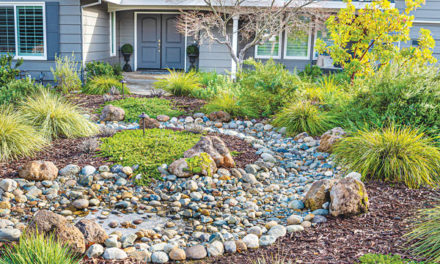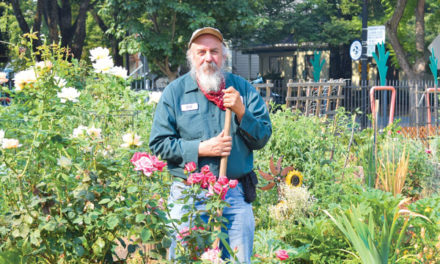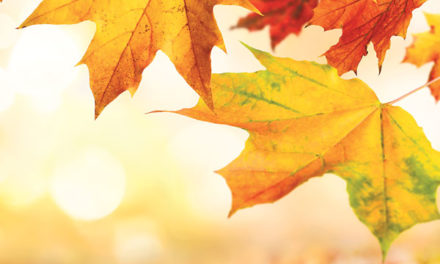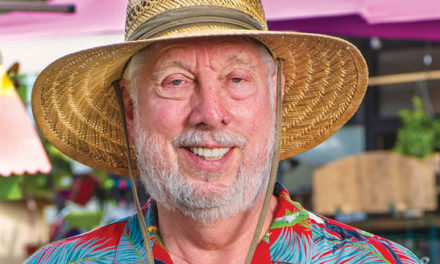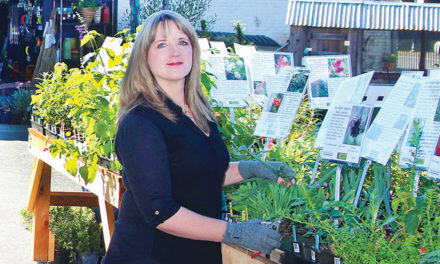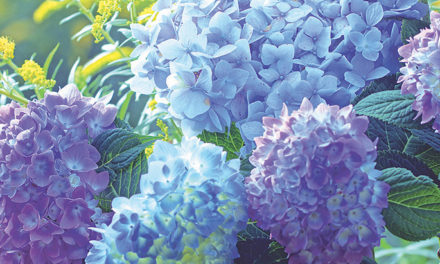Crazy for Color
The garden is no place to be bashful
By Anita Clevenger
June 2018
There are few entries in my baby book. My mother was a hardworking farm wife with two children, much too busy to be documenting my every tooth and step. One of the few things she wrote was “Anita loves flowers—22 months.” Decades later, I still do.

I first encountered the term “flower floozy” at Annie’s Annuals & Perennials, a wonderful nursery in Richmond, and recognized kindred spirits among the staff and customers. This nursery began by specializing in annual plants, which pump out flowers, set seed and die in a single season. Annie’s now offers other types of plants, but flowers still rule.
What is it about flowers? While I love their fragrance and form, their color makes me weak in the knees. I appreciate the restfulness of a mostly green garden and the purity of a white garden, but I want pink, red, orange, yellow, purple and blue, and lots of it.
These colors don’t necessarily blend well. Tastes vary, but I prefer gardens where colors have been chosen carefully rather than mixed together randomly. Many books and articles have been written about the use of color in the garden, often referring to the color wheel to explain how colors interact.
The color wheel contains the full range of colors. You can choose colors in a triad, equally spaced around the wheel. Complementary colors are opposite, while analogous colors are next to one another. Monochromatic schemes are the same hue, often in different shades. Pastels give an English-garden look. Bright colors can look tropical. Colors ranging from red through chartreuse are considered hot. They seem to advance and make a space seem smaller. Blues, violets and greens are cool and seem to recede.
At my house, I have relegated hot colors to a narrow border along the driveway where they can throw a loud party without upsetting the more genteel pastel and cooler tones of my main garden. Big purple canna leaves contrast with their orange flowers and with the brilliant yellow and orange blossoms on ‘Joseph’s Coat’ rose and Mexican lobelia. It’s hot, hot, hot out there.
Walk through the garden gate and you find a still-colorful but more subdued garden. I grow many roses from the 19th century, which by definition do not come in the bright yellow or orange tones that were first introduced in the 1920s and 1930s. Deep-red roses punctuate the garden. Some old roses have peachy tones, and they grow in one section of the garden offset by the purple and blue flowers on varieties of salvia, veronica, teucrium and plumbago.
It’s helpful to look at gardening books and pay attention to what you like when you walk through the neighborhood or visit gardens near and far. If you like a combination, consider what appeals to you.
While I don’t care for an all-white garden under our blazing Sacramento sun, white or light-colored flowers interspersed with other plantings can cool things off and stay visible as the sun goes down. Darker colors disappear at dusk.
What are some of my other favorite flowering plants? I love bearded iris, with extravagant ruffled flowers that came in many hues. (Iris was the Greek goddess of the rainbow.) Some iris varieties repeat bloom in the fall, an added bonus. I like spring bulbs such as tulips and narcissus, which pop with color at a time of the year when very little else is blooming.
Drought-tolerant gardens can be drab if you pick mostly grasses and plants that go dormant in the summer. You can have nearly year-round color by carefully selecting what you grow. In the spring, small trees and shrubs such as ceanothus, flannel bush and redbud bloom blue, gold and magenta. California poppies will repeat bloom if you cut them back after their first flowering. In the summer, Bidens and other members of the daisy family bear bright-yellow flowers. Red buckwheat gives a nice contrast and holds its color for months. Autumn sage comes in almost every color. Spanish lavender blooms heavily and is fairly long-lived, unlike many other lavender varieties. California fuchsias bear fluorescent orange and red flowers for a long, bee-busy season.
A photographer once visited the Historic Rose Garden where I volunteer. As he bounded excitedly from rose to rose, he stopped at an intensely purple-violet flower and shouted, “I live for this color!” I do, too, and all of the others in the flower rainbow.
Anita Clevenger is a Lifetime Sacramento County UC Master Gardener. For answers to gardening questions, call the UC Master Gardeners at (916) 876-5338 or go to sacmg.ucanr.edu.



































